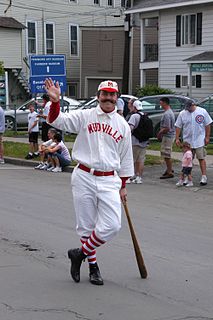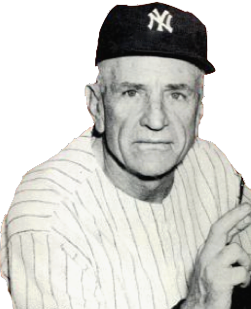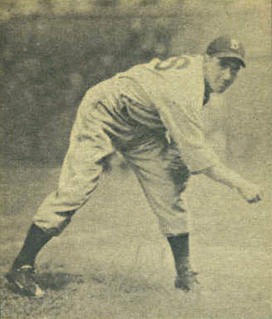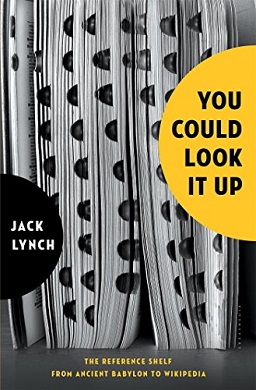
"Casey at the Bat: A Ballad of the Republic Sung in the Year 1888" is a baseball poem written in 1888 by Ernest Thayer. First published in The San Francisco Examiner on June 3, 1888, it was later popularized by DeWolf Hopper in many vaudeville performances. It has become one of the best-known poems in American literature. The poem was originally published anonymously.

Charles Dillon "Casey" Stengel was an American Major League Baseball right fielder, and manager, best known as the manager of both the championship New York Yankees of the 1950s and later, of the expansion New York Mets. He was elected to the Baseball Hall of Fame in 1966.

Rinold George "Ryne" Duren was an American relief pitcher in Major League Baseball.

Norman Arthur "Kid" Elberfeld was an American professional baseball shortstop. He played in Major League Baseball (MLB) for the Philadelphia Phillies (1898), Cincinnati Reds (1899), Detroit Tigers (1901–1903), New York Highlanders (1903–1909), Washington Senators (1910–1911), and Brooklyn Robins (1914). Elberfled also managed the New York Highlanders for the last half of the 1908 season.

Marvin Eugene Throneberry was an American Major League Baseball player. Affectionately known as "Marvelous Marv", he was the starting first baseman for the 1962 New York Mets, a team which set the modern record for most losses in a season with 120.

Joseph Vincent McCarthy was a manager in Major League Baseball, most renowned for his leadership of the "Bronx Bombers" teams of the New York Yankees from 1931 to 1946. The first manager to win pennants with both National and American League teams, he won nine league titles overall and seven World Series championships – a record tied only by Casey Stengel. McCarthy was elected to the Baseball Hall of Fame in 1957.
The 1952 World Series featured the 3-time defending champions New York Yankees beating the Brooklyn Dodgers in seven games. The Yankees won their 4th consecutive title, tying the mark they set in 1936–1939 under manager Joe McCarthy, and Casey Stengel became the second manager in Major League history with 4 consecutive World Series championships. This was the Yankees' 15th World Series championship win, and the 3rd time they defeated the Dodgers in 6 years.
The 1958 World Series was a rematch of the 1957 World Series, with the New York Yankees beating the defending champion Milwaukee Braves in seven games for their 18th title, and their seventh in 10 years. With that victory, the Yankees became only the second team in Major League Baseball history to come back from a 3–1 deficit to win a best-of-seven World Series; the first was the Pittsburgh Pirates in 1925. These teams would meet again in the fall classic thirty-eight years later—by that time, the Braves had moved to Atlanta. As of 2019, this is the most recent World Series featuring the two previous Series winning teams.
In the 1923 World Series, the New York Yankees beat the New York Giants in six games. This would be the first of the Yankees' 27 World Series championships. The series was not played in a 2–3–2 format: as with the previous two Series the home field alternated each game, though this time it involved switching ballparks, as the first Yankee Stadium had opened this season.

Eugene Richard Woodling was a professional baseball player. He played all or part of seventeen seasons in Major League Baseball for the Cleveland Indians, Pittsburgh Pirates (1947), New York Yankees (1949–54), Baltimore Orioles, Washington Senators (1961–62), and the New York Mets in their expansion year of 1962. Primarily an outfielder, he played most often in left field. The Akron, Ohio, native batted left-handed, threw right-handed, and was listed as 5 feet 9 inches (1.75 m) tall and 195 pounds (88 kg).

Van Lingle Mungo was a Major League Baseball right-handed pitcher known for his career with the Brooklyn Robins/Dodgers. Mungo played for the Dodgers from 1931 to 1941 and finished his baseball career with the New York Giants.
The platoon system in baseball or football is a method directing the situational substitution of players to create tactical advantage.
Steven Goldman is an American sports writer on Major League Baseball.
I Managed Good, But Boy Did They Play Bad is a collection of essays, short stories and articles about baseball, combined with comments and articles written by Ball Four author and former major league pitcher Jim Bouton.
The 1918 Brooklyn Robins finished the season in fifth place.

Elections to the Baseball Hall of Fame for 1966 followed the system introduced for even-number years in 1956. The Baseball Writers' Association of America (BBWAA) voted by mail to select from recent major league players with provision for a second, "runoff" election in case of no winner. Ted Williams tallied more than 90% on the first ballot. Meanwhile, the Veterans Committee was meeting annually to consider executives, managers, umpires, and earlier major league players. It selected Casey Stengel. A formal induction ceremony was held in Cooperstown, New York, on July 25, 1966, with Commissioner of Baseball William Eckert presiding. During his acceptance speech, Williams advocated for the inclusion of Negro league baseball players, such as Satchel Paige and Josh Gibson, in the Hall of Fame. Paige was inducted in 1971, and Gibson in 1972.

Casey Stengel a public sculpture by American artist, Rhoda Sherbell, is located on the Indiana University-Purdue University Indianapolis campus, which is near downtown Indianapolis, Indiana. The sculpture can be found in the courtyard of the University Place Hotel. Installed in 2000, the sculpture was cast in bronze with a height of 43 inches.
Stengel is a surname. Notable people with the surname include:










